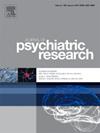母亲围产期抑郁症和后代注意缺陷和多动障碍的风险:一项相关数据研究
IF 3.7
2区 医学
Q1 PSYCHIATRY
引用次数: 0
摘要
本研究考察了围产期抑郁症母亲的后代患注意力缺陷/多动障碍(ADHD)的风险,考虑了不良出生结局的直接和间接途径。方法本研究采用回顾性队列设计,利用新南威尔士州与行政相关的健康数据。使用《国际疾病分类,第十版,澳大利亚修订版》(ICD-10-AM)代码对产妇围产期抑郁症和后代ADHD进行鉴定。采用二项分布和对数链接函数的广义线性模型来估计直接关联。此外,我们还进行了中介分析,以检验低出生体重、低Apgar评分和早产在母亲产前抑郁障碍与后代ADHD之间的中介作用。结果在调整混杂因素后,患有产前、产后和围产期抑郁症的母亲的后代患ADHD的风险分别高出2.10倍(95% CI: 1.46-3.03)、1.80倍(95% CI: 1.11-2.92)和2.16倍(95% CI: 1.57-2.97)。早产在产前抑郁与ADHD之间的中介作用最小,仅占总效应的0.73%,比直接效应小约45倍。低出生体重和低阿普加评分没有介导这种关系。结论:我们的研究表明,母亲围产期抑郁障碍与后代ADHD风险增加有关,不良出生结果的中介作用非常小或没有中介作用。因此,实施旨在改善孕产妇心理健康的早期干预策略对于降低儿童患多动症的风险至关重要。本文章由计算机程序翻译,如有差异,请以英文原文为准。
Maternal perinatal depressive disorders and the risk of attention deficit and hyperactivity disorder in offspring: A linked data study
Background
This study examines the risk of Attention-Deficit/Hyperactivity Disorder (ADHD) in offspring of mothers with perinatal depressive disorders, considering direct and indirect pathways through adverse birth outcomes.
Methods
The study employed a retrospective cohort design, utilising administrative-linked health data from New South Wales. Maternal perinatal depressive disorders and offspring ADHD were identified using the International Classification of Diseases, Tenth Revision, Australian Modification (ICD-10-AM .) codes. A generalised linear model with a binomial distribution and log link function was used to estimate the direct association. Additionally, a mediation analysis was conducted to examine the mediating effects of low birth weight, low Apgar scores, and preterm birth on the association between maternal antenatal depressive disorder and offspring ADHD.
Results
After adjusting for confounders, offspring of mothers with antenatal, postnatal, and perinatal depressive disorders had 2.10 (95 % CI: 1.46–3.03), 1.80 (95 % CI: 1.11–2.92), and 2.16 (95 % CI: 1.57–2.97) times greater risk of ADHD, respectively. Preterm birth minimally mediated the relationship between antenatal depression and ADHD, accounting for only 0.73 % of the total effect, which was about 45 times smaller than the direct effect. Low birth weight and low Apgar scores did not mediate this relationship.
Conclusion
Our study revealed that maternal perinatal depressive disorders are associated with an increased risk of offspring ADHD, with very minimal or no mediating effects from adverse birth outcomes. Therefore, implementing early intervention strategies aimed at improving maternal mental health is crucial to reducing the risk of ADHD in children.
求助全文
通过发布文献求助,成功后即可免费获取论文全文。
去求助
来源期刊

Journal of psychiatric research
医学-精神病学
CiteScore
7.30
自引率
2.10%
发文量
622
审稿时长
130 days
期刊介绍:
Founded in 1961 to report on the latest work in psychiatry and cognate disciplines, the Journal of Psychiatric Research is dedicated to innovative and timely studies of four important areas of research:
(1) clinical studies of all disciplines relating to psychiatric illness, as well as normal human behaviour, including biochemical, physiological, genetic, environmental, social, psychological and epidemiological factors;
(2) basic studies pertaining to psychiatry in such fields as neuropsychopharmacology, neuroendocrinology, electrophysiology, genetics, experimental psychology and epidemiology;
(3) the growing application of clinical laboratory techniques in psychiatry, including imagery and spectroscopy of the brain, molecular biology and computer sciences;
 求助内容:
求助内容: 应助结果提醒方式:
应助结果提醒方式:


